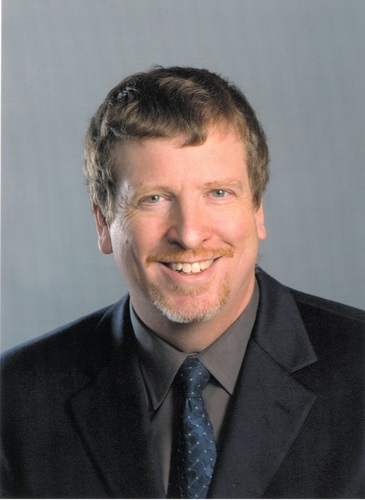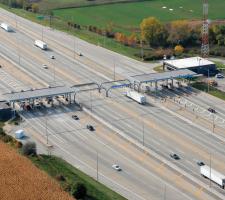
Richard Turnock
RSS63 IBTTA) and the Alliance for Toll Interoperability (ATI) , driven by the Moving Ahead for Progress in the 21st Century (MAP-21) Act.
A critical component of national interoperability is achieving consensus and establishing standards that enable transponders to be read universally across the nation. In order to advance this essential element,4984 Kapsch TrafficCom North America recently released its Time Division Multiplexing (TDM) protocol specification as an open standard to the industry. The TDM protocol is the most widely used electronic toll collection protocol in North America and serves as the foundation for interoperability for 25 million users and 25 agencies that comprise the current 4981 E-ZPass Group. The E-ZPass Group, the largest interoperability group in the world, is fully engaged at all levels and continues to support the industry’s efforts to achieve nationwide interoperability.
Achieving national interoperability will not be easy. Central to the goal is the need for universal electronic toll reader-transponder interoperability – in other words the ability for a single transponder to be used seamlessly for tolls across the country, independent of the tolling authority responsible for the particular roadway. The array of existing standards creates a particular challenge to achieving national interoperability. One solution would be to retain individual transportation authorities’ ability to choose their own local tolling technology standard, while establishing a single, overarching national technology. This single technology solution could be implemented as a stand-alone system or as part of a multi-protocol facility.
Recognising this need, IBTTA set up an Interoperability Committee, composed of representatives from leading industry groups and major US tolling regions/authorities. This committee has created a draft set of recommendations and technology requirements for achieving national interoperability. In its March 19, 2013 progress report, IBTTA stated that to be considered for the national standard, a transponder protocol must meet a minimum set of operating requirements and message data formats. Contenders must also employ ‘open’ technical and design standards which means the use of non-proprietary protocols in transponders, readers and related equipment that can be built and sold by any entity meeting the testing and certification requirements.
Kapsch’s TDM protocol is the foundation of the E-ZPass Group’s interoperable electronic toll collection and is now openly available to all interested parties, along with the modifications and improvements made by those parties. Opening of the protocol means Kapsch’s TDM now fulfils IBTTA’s recommendation and can establish the nation’s most widely-used interoperable technology as the national standard.
There are a number of advantages for nationwide adoption of the now-open Kapsch TDM protocol, not least of which is that E-ZPass is the nation’s most widely accepted protocol with more than 25 million active subscribers. It has already been validated as an acceptable protocol with more than $7 billion collected annually in toll revenues and is compliant with the current IBTTA Interoperability Committee’s requirements. Kapsch has also stated its commitment to ensuring standardisation requirements promulgated by the Committee. The published protocol will remain an open specification available to anyone through a royalty-free, perpetual, assignable license agreement. In addition the long practice of the protocol minimises the likelihood of patent related litigation.
As an open protocol the likelihood of vendor contests is minimised, the only requirement is the need to accept a license agreement in which the accessing party commits to make available, without restriction, any future modifications or enhancements. By releasing the TDM specification in this open manner, Kapsch has made it possible for any developer or company to provide toll authorities and concessionaires with optimised toll transactions based upon industry-leading technology.
Clearly there is more to making a standard available for free competition than simply providing its specification to licensed users. To truly enable free competition, Kapsch has documented the TDM protocol for toll collection and ensures through the license, that natural development of enhancements or improvements will also continue to be open. TDM does not include any proprietary aspect and is therefore not subject to patents or other legislation that would restrict licensing. Thus, Kapsch’s TDM protocol meets all these requirements for being truly open. At Kapsch we believe that many other supposedly ‘open’ standards do not meet all these requirements.
Another consideration is that standards bodies such as the Institute of Electrical and Electronics Engineers (IEEE) and the International Organisation for Standardisation (ISO) often release standard documents under copyright but recognise that there may be patents that must be licensed in order to practice the standard. Sometimes potentially required patents are listed in the standard while others carry statements such as; ‘attention is drawn to the possibility that some of the elements of this document may be the subject of patent rights other than those identified…’. The risk associated with this approach is demonstrated by previous and ongoing patent lawsuits.
The simple existence of a standard does not necessarily lead to interoperability or consistent performance. For example, standards not originally intended for tolling do not include a specification for performance of a transponder attached to a vehicle windshield. There are cases of transponders built to the same standard by different vendors performing so differently that a reader cannot be optimised for all vendor protocols which then compromises performance. To avoid this problem, Kapsch has endeavoured to include all sufficient requirements necessary for tolling performance into the open TDM protocol.
While Kapsch requires interested parties to sign a license agreement, this is intended to protect present and future users of the protocol and support its continued openness. An analogy is that radio engineers know how to build a radio transmitter but there needs to be some regulatory structure in place to ensure that the airwaves are properly shared. With the TDM protocol, certain portions of the data exchanged between the transponder and reader need to be controlled to ensure interoperability and the licensing agreement ensures all future enhancements are interoperable and available to all users.
While achieving US-wide electronic toll interoperability requires more than simply enabling reading of multiple protocols at the lane level, Kapsch’s release of the most widely used electronic toll collection protocol in North America is a major step toward national interoperability. The technology is well proven, providing greater than 99.9% accuracy (read and write) for the E-ZPass Group, and is used daily by tens of millions of motorists. Kapsch believes the industry-wide, in perpetuity, release of the TDM protocol is a major contribution to the industry’s aim of enabling travellers to drive from Maine to California without fear of toll violation – from Sea to Shining Sea.RSS
Richard Turnock, chief technology officer of Kapsch TrafficCom North America explains what advantages its newly-opened TDM protocol can offer as a US-wide standard for tolling interoperability.
The electronic tolling industry across the United States is evolving. Historically it was characterised by clusters of interoperability where a motorist may be able to use the same transponder across a large area, such as the 15-State E-ZPass system, or be confined to a single State system. Now, however, the industry is focused on linking these systems and moving toward national interoperability. A collaborative effort is underway between industry groups including the International Bridge, Tunnel and Turnpike Association (A critical component of national interoperability is achieving consensus and establishing standards that enable transponders to be read universally across the nation. In order to advance this essential element,
Towards nationwide interoperability
The MAP-21 has propelled tolling interoperability to the forefront of industry discussions. It mandates that within four years of enactment, Federal-aided highway toll facilities must implement technologies or business practices that provide for interoperability of electronic toll collection (ETC) programs. Aside from the priority of improving the customer experience on US toll roads, compliance with MAP-21 is paramount for agencies and concessionaires receiving Federal-aid funding.Achieving national interoperability will not be easy. Central to the goal is the need for universal electronic toll reader-transponder interoperability – in other words the ability for a single transponder to be used seamlessly for tolls across the country, independent of the tolling authority responsible for the particular roadway. The array of existing standards creates a particular challenge to achieving national interoperability. One solution would be to retain individual transportation authorities’ ability to choose their own local tolling technology standard, while establishing a single, overarching national technology. This single technology solution could be implemented as a stand-alone system or as part of a multi-protocol facility.
Recognising this need, IBTTA set up an Interoperability Committee, composed of representatives from leading industry groups and major US tolling regions/authorities. This committee has created a draft set of recommendations and technology requirements for achieving national interoperability. In its March 19, 2013 progress report, IBTTA stated that to be considered for the national standard, a transponder protocol must meet a minimum set of operating requirements and message data formats. Contenders must also employ ‘open’ technical and design standards which means the use of non-proprietary protocols in transponders, readers and related equipment that can be built and sold by any entity meeting the testing and certification requirements.
Single model
As the largest electronic tolling network in the world, the E-ZPass Group could be a model for nationwide interoperability. During more than 20 years of operation, business rules between agencies have been established, financial clearing processes and reconciliation methods have been put in place and the technologies for delivering a transponder record have been implemented.Kapsch’s TDM protocol is the foundation of the E-ZPass Group’s interoperable electronic toll collection and is now openly available to all interested parties, along with the modifications and improvements made by those parties. Opening of the protocol means Kapsch’s TDM now fulfils IBTTA’s recommendation and can establish the nation’s most widely-used interoperable technology as the national standard.
There are a number of advantages for nationwide adoption of the now-open Kapsch TDM protocol, not least of which is that E-ZPass is the nation’s most widely accepted protocol with more than 25 million active subscribers. It has already been validated as an acceptable protocol with more than $7 billion collected annually in toll revenues and is compliant with the current IBTTA Interoperability Committee’s requirements. Kapsch has also stated its commitment to ensuring standardisation requirements promulgated by the Committee. The published protocol will remain an open specification available to anyone through a royalty-free, perpetual, assignable license agreement. In addition the long practice of the protocol minimises the likelihood of patent related litigation.
As an open protocol the likelihood of vendor contests is minimised, the only requirement is the need to accept a license agreement in which the accessing party commits to make available, without restriction, any future modifications or enhancements. By releasing the TDM specification in this open manner, Kapsch has made it possible for any developer or company to provide toll authorities and concessionaires with optimised toll transactions based upon industry-leading technology.
Standards, Open Protocol and Licensing
Kapsch supports the global use of standards in electronic toll collection. The release of the TDM protocol enables unrestricted competition to provide both readers and transponders throughout North America and creates a high-performing option for meeting the goals of MAP-21.Clearly there is more to making a standard available for free competition than simply providing its specification to licensed users. To truly enable free competition, Kapsch has documented the TDM protocol for toll collection and ensures through the license, that natural development of enhancements or improvements will also continue to be open. TDM does not include any proprietary aspect and is therefore not subject to patents or other legislation that would restrict licensing. Thus, Kapsch’s TDM protocol meets all these requirements for being truly open. At Kapsch we believe that many other supposedly ‘open’ standards do not meet all these requirements.
Another consideration is that standards bodies such as the Institute of Electrical and Electronics Engineers (IEEE) and the International Organisation for Standardisation (ISO) often release standard documents under copyright but recognise that there may be patents that must be licensed in order to practice the standard. Sometimes potentially required patents are listed in the standard while others carry statements such as; ‘attention is drawn to the possibility that some of the elements of this document may be the subject of patent rights other than those identified…’. The risk associated with this approach is demonstrated by previous and ongoing patent lawsuits.
The simple existence of a standard does not necessarily lead to interoperability or consistent performance. For example, standards not originally intended for tolling do not include a specification for performance of a transponder attached to a vehicle windshield. There are cases of transponders built to the same standard by different vendors performing so differently that a reader cannot be optimised for all vendor protocols which then compromises performance. To avoid this problem, Kapsch has endeavoured to include all sufficient requirements necessary for tolling performance into the open TDM protocol.
While Kapsch requires interested parties to sign a license agreement, this is intended to protect present and future users of the protocol and support its continued openness. An analogy is that radio engineers know how to build a radio transmitter but there needs to be some regulatory structure in place to ensure that the airwaves are properly shared. With the TDM protocol, certain portions of the data exchanged between the transponder and reader need to be controlled to ensure interoperability and the licensing agreement ensures all future enhancements are interoperable and available to all users.
While achieving US-wide electronic toll interoperability requires more than simply enabling reading of multiple protocols at the lane level, Kapsch’s release of the most widely used electronic toll collection protocol in North America is a major step toward national interoperability. The technology is well proven, providing greater than 99.9% accuracy (read and write) for the E-ZPass Group, and is used daily by tens of millions of motorists. Kapsch believes the industry-wide, in perpetuity, release of the TDM protocol is a major contribution to the industry’s aim of enabling travellers to drive from Maine to California without fear of toll violation – from Sea to Shining Sea.RSS













